
GAMBIT in the houseby Dwayne Day
|
| There were 40 GAMBITs built, but only 38 launched, the last one in June 1967. With the GAMBIT-3 operational, the last two GAMBIT-1s were placed in storage. |
The GAMBIT emerged in 1960 as a sort of phoenix out of the ashes of the US Air Force’s Samos program. Samos involved several Air Force-led efforts to develop various reconnaissance satellites. The first projects, designated Samos E-1 and E-2, were film-readout satellites that would use traditional film to capture an image, develop that film on orbit, and then scan the image with the equivalent of a fax machine. But to hedge their bets, Air Force officials also started film-return satellites as well, designated Samos E-5 and E-6. All of the Samos projects were all running into problems by 1960 at the same time that the intelligence community had identified a requirement for much higher resolution imagery with the primary goal of measuring the size of Soviet ICBMs on the ground, and using this information to determine their fuel capacity. President Eisenhower approved the GAMBIT satellite to gather this and other information. GAMBIT would use a camera developed by Eastman Kodak and a satellite developed by General Electric. It would produce long strips of film, store them in a reentry vehicle, and send that reentry vehicle back to Earth.
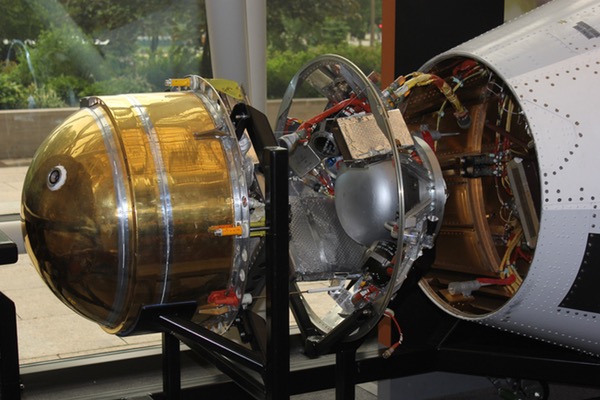 A GAMBIT spy satellite on display at the National Air and Space Museum. (credit: D. Day) |
The first satellite worked in orbit, as did the second and third, but they suffered teething problems that were eventually worked out. The GAMBIT had two large mirrors on either end of a long tube. One mirror reflected the ground below the satellite into the tube and onto the other mirror, which focused it and sent the light back down the tube onto a large strip of film that was pulled across a thin slit. The camera system could expose a long thin image of the ground at high resolution. The exact resolution remains classified, but the laws of physics make it possible to calculate the theoretical resolution. In actual use, the satellites apparently produced images of objects on the ground of 45–60 centimeters (18–24 inches.)
 GAMBIT spacecraft schematic. |
There were 40 GAMBITs built, but only 38 launched, the last one in June 1967. By this time the GAMBIT had been superseded by a larger and more powerful version designated GAMBIT-3, and thus the earlier versions were labeled GAMBIT-1. The GAMBIT-3 had ridiculously high resolution and was apparently able to spot a baseball lying in a parking lot as the GAMBIT sailed overhead. With the GAMBIT-3 operational, the last two GAMBIT-1s were placed in storage.
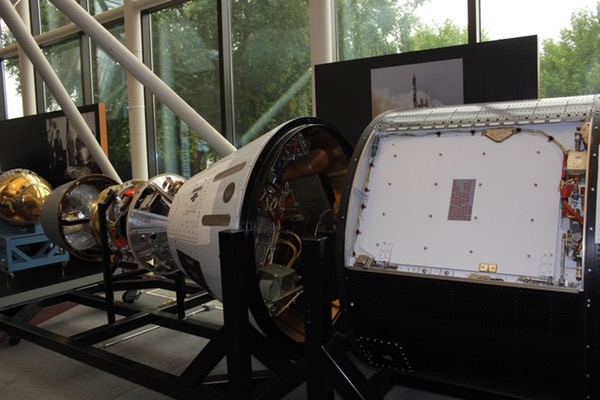 A GAMBIT spy satellite on display at the National Air and Space Museum. (credit: D. Day) |
In 1995, the CIA and the National Reconnaissance Office, which managed the United States’ intelligence satellite effort, declassified the first photo-reconnaissance satellite program known as CORONA and turned over a CORONA camera system to the Smithsonian Institution. The CORONA that has been on display in the National Air and Space Museum in Washington, DC for the past two decades is not a flight object but contains a single engineering camera from late in the program coupled with leftover and mockup equipment. When CORONA was declassified, intelligence officials began discussing declassifying the systems that followed it, GAMBIT and HEXAGON, and by 1996 they were planning on declassifying both of them within a few years.
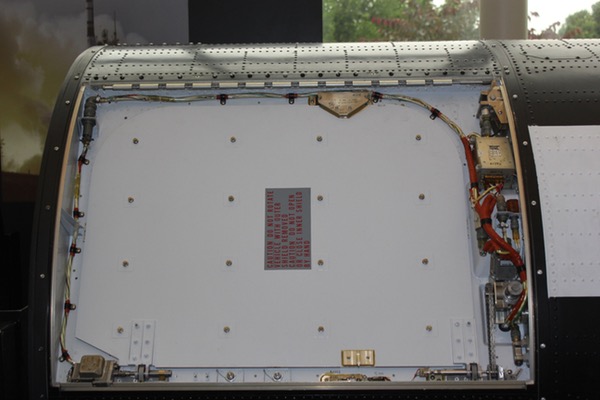 A GAMBIT spy satellite on display at the National Air and Space Museum. (credit: D. Day) |
In 1997 the then-director of the National Reconnaissance Office, Keith Hall, paid a visit to the museum and enthusiastically discussed with museum officials the planned donation of several large reconnaissance artifacts to the museum. Hall did not mention their names, but did provide their dimensions so that museum curators could plan on where to put them. The objects included the HEXAGON camera system, a massive satellite that performed area searches of the Soviet Union looking for changes. Another object was a GAMBIT satellite. Hall was quite certain that they would be turned over to the museum soon, and museum curators even staked out a location for the HEXAGON in their planned new annex museum near Dulles airport (See: “The invisible Big Bird: Why there is no KH-9 spy satellite in the Smithsonian,” The Space Review, November 8, 2004).
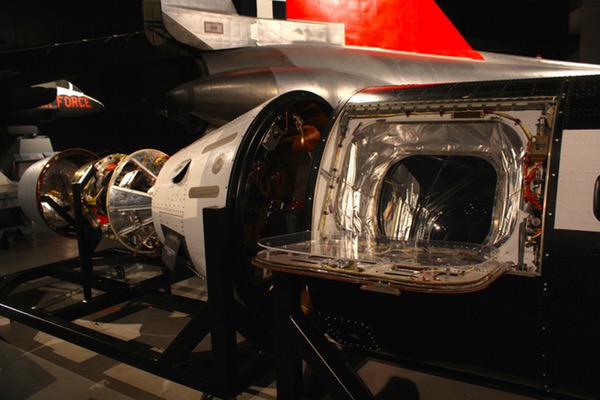 A GAMBIT spy satellite at the National Museum of the US Air Force. (credit: D. Day) |
| The Smithsonian’s satellite is on a ten-year loan from the NRO and faces nose-to-nose with the CORONA. |
But the declassification effort ran into snags and it was delayed. In August 2002, the government declassified imagery from the GAMBIT-1 and the HEXAGON’s mapping camera, although it did not release the names of the systems that produced the imagery, and in fact never even mentioned that the images were produced by satellites. Slowly, over the next few years, a few more details about the GAMBIT-1 system were released, including its focal length and its basic operating modes. But it was not until the fall of 2011 that the National Reconnaissance Office released substantial amounts of information about both the GAMBIT and HEXAGON programs and displayed both systems for a single day at the Smithsonian’s Steven F. Udvar-Hazy Center. At the time, the museum was preparing for the arrival of the space shuttle Discovery and the transfer of the Enterprise and did not have space at the Udvar-Hazy Center to display either the HEXAGON or the GAMBIT-1. Later the HEXAGON, a GAMBIT-1, and parts of a GAMBIT-3 (no final complete flight model of the GAMBIT-3 remained) were put on display at the National Museum of the US Air Force.
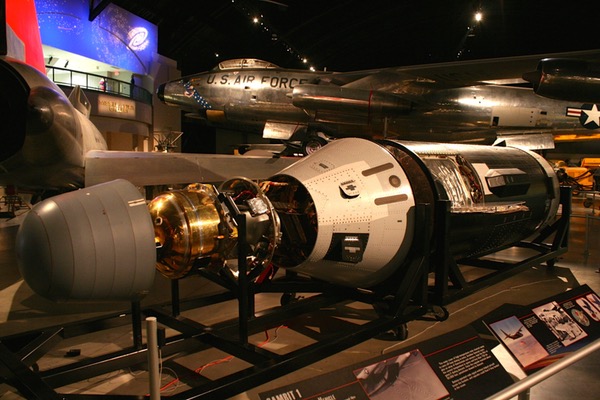 A GAMBIT spy satellite at the National Museum of the US Air Force. (credit: D. Day) |
Now, after several years, the National Air and Space Museum has obtained a GAMBIT-1 for display. This is the second-to-last GAMBIT-1 built; the last one is at the Air Force museum. The GAMBIT-1 still has its camera port closed, but a museum curator and technicians plan to open it soon so that visitors can see the large image reflecting mirror inside. Both the Smithsonian and Air Force Museum GAMBITs also have two antennas stowed, although these were deployed during the brief display at the Udvar-Hazy Center in 2011. The Smithsonian’s satellite is on a ten-year loan from the National Reconnaissance Office and faces nose-to-nose with the CORONA. This is fitting because not only did both satellites operate during the same time, but GAMBIT used the same film-return recovery system originally developed for CORONA, which lowered costs and increased reliability.
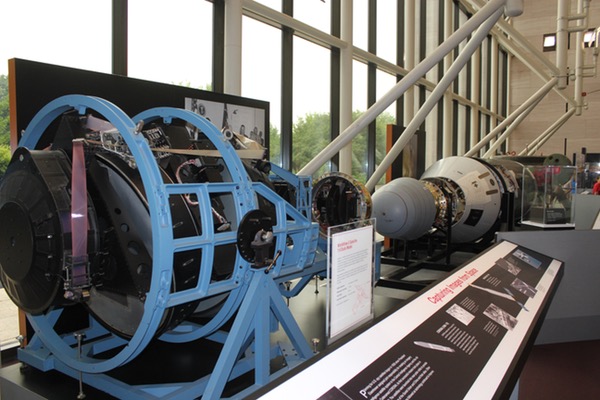 A GAMBIT spy satellite on display at the National Air and Space Museum, nose to nose with the CORONA. (credit: D. Day) |
The National Air and Space Museum will begin undergoing a massive renovation project in the next few years that is likely to close various parts of the museum for significant periods of time, although current plans are to keep the museum itself open during the renovation. Thus, the GAMBIT-1 may go into storage for awhile, or could end up at the Udvar-Hazy Center. If you’re planning on visiting Washington, DC in the near future, make sure to see it while you still can.